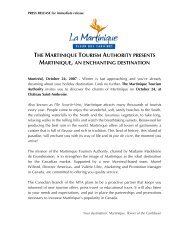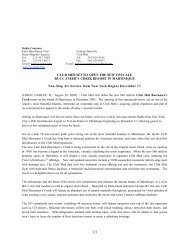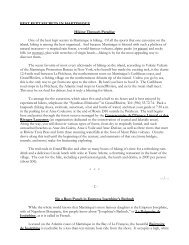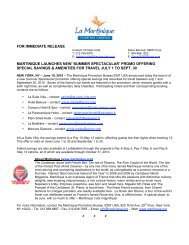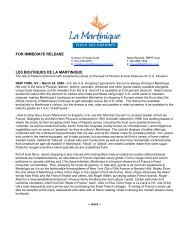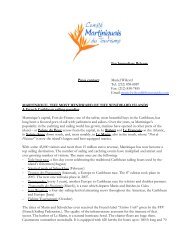sales guide martinique
sales guide martinique
sales guide martinique
You also want an ePaper? Increase the reach of your titles
YUMPU automatically turns print PDFs into web optimized ePapers that Google loves.
General Information<br />
History<br />
It was in 1502, on his fourth voyage to the New World,<br />
that Christopher Columbus landed in Martinique. At<br />
that time, the island was inhabited by the Carib Indians,<br />
who had earlier chased out the Arawak Indians. Like<br />
the Caribs, the Arawaks had originally come from the<br />
Orinoco River Valley, near the northern coast of South<br />
America. It was on Columbus’ arrival that Martinique<br />
was dubbed Madinina, « the island of flowers. »<br />
Martinique Today<br />
Geography<br />
Situated in the heart of the Caribbean archipelago,<br />
Martinique belongs to the “Windward Islands” of the<br />
Lesser Antilles. Its coasts are lapped in the east by<br />
the Atlantic Ocean and in the west by the Caribbean<br />
Sea. Martinique is 4,350 miles from Paris, 1,950 miles<br />
from New York, and 275 miles from the coast of<br />
South America. Its nearest neighbors to the north are<br />
Domenica (16 miles away) and Guadeloupe (75 miles),<br />
and its nearest neighbor to the south is Saint Lucia (23<br />
miles). Martinique is equidistant between Venezuela<br />
and Haïti/Domincan Republic, at 497 miles from both.<br />
Topography<br />
Martinique is 425 square miles in size. It is 50 miles<br />
long at its longest, and just over 24 miles wide at its<br />
widest. The northern part of the island is geologically<br />
young and active, characterized by mountains (Mount<br />
Pelée is the highest at 4,483 feet), dense forests,<br />
rivers, and cascades. In the center, the Lamentin Plain<br />
makes the transition from the mountainous north to<br />
the south’s gentler and geologically older landscape<br />
of rolling hills. The southern coast is dotted with many<br />
lovely bays and coves. In the southernmost part of the<br />
island, a savanna of petrified trees is a true geological<br />
curiosity.<br />
Since 1635, with the exception of two short periods<br />
of British occupation, Martinique’s destiny was tied<br />
to France. Today, Martinique is simultaneously an<br />
official department of France (since 1946) and an<br />
official region of France (since 1982). The seat of the<br />
prefectural government, Fort-de-France, is the main<br />
administrative and economic center of Martinique.<br />
Martinique is divided into three sub-prefectures :<br />
- Trinité, covering the northern Atlantic coast<br />
- Saint-Pierre, covering the northern Caribbean<br />
coast<br />
- Le Marin, covering the south<br />
Flora and Fauna<br />
Due to its tropical climate, Martinique is covered with a<br />
mantle of lush vegetation: sumptuous rainforests, bush,<br />
savannah, and innumerable species of trees, fruits,<br />
plants and flowers...and don’t forget the mangroves.<br />
This ensemble makes Martinique an extraordinary<br />
garden.<br />
The fauna is essentially composed of birds, fish and<br />
crustaceans, but there are also iguanas, small lizards<br />
called mabouyas or anolis, and trigonocephale snakes<br />
unique to the island. The manicou, a kind of possum,<br />
is one of the few mammals to have made the Antilles<br />
their home. The mongoose, on the other hand, was<br />
introduced by man to keep the snake population in<br />
check.<br />
Climate<br />
The climate is relatively mild in Martinique. It never<br />
gets very hot. The average temperature of 79 degrees<br />
graces the island with an “eternal summer.” Breezes<br />
from the east and northeast, the Alizes, constantly<br />
cool and refresh the island.<br />
Normal Seasonal Temperatures (C°) and Rates of<br />
Precipitation (in millimeters)<br />
Temp<br />
Rain<br />
Jan.<br />
25<br />
123<br />
Feb.<br />
25<br />
88<br />
Mar.<br />
25,4<br />
90<br />
Apr.<br />
26,1<br />
100<br />
May<br />
27,1<br />
113<br />
June<br />
27,6<br />
153<br />
Temp<br />
Rain<br />
July<br />
27,5<br />
182<br />
Aug.<br />
27,5<br />
267<br />
Sept.<br />
27,3<br />
238<br />
Oct.<br />
27<br />
262<br />
Nov.<br />
26,5<br />
267<br />
Dec.<br />
25,7<br />
160<br />
8




